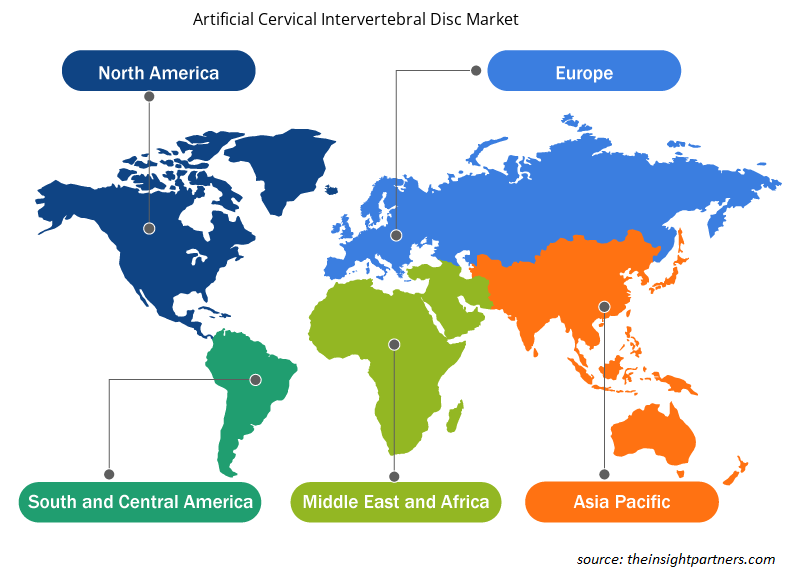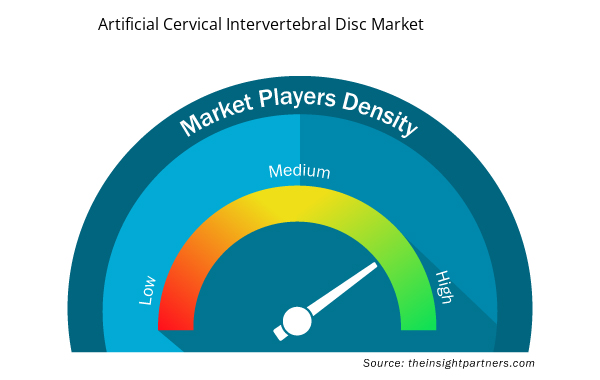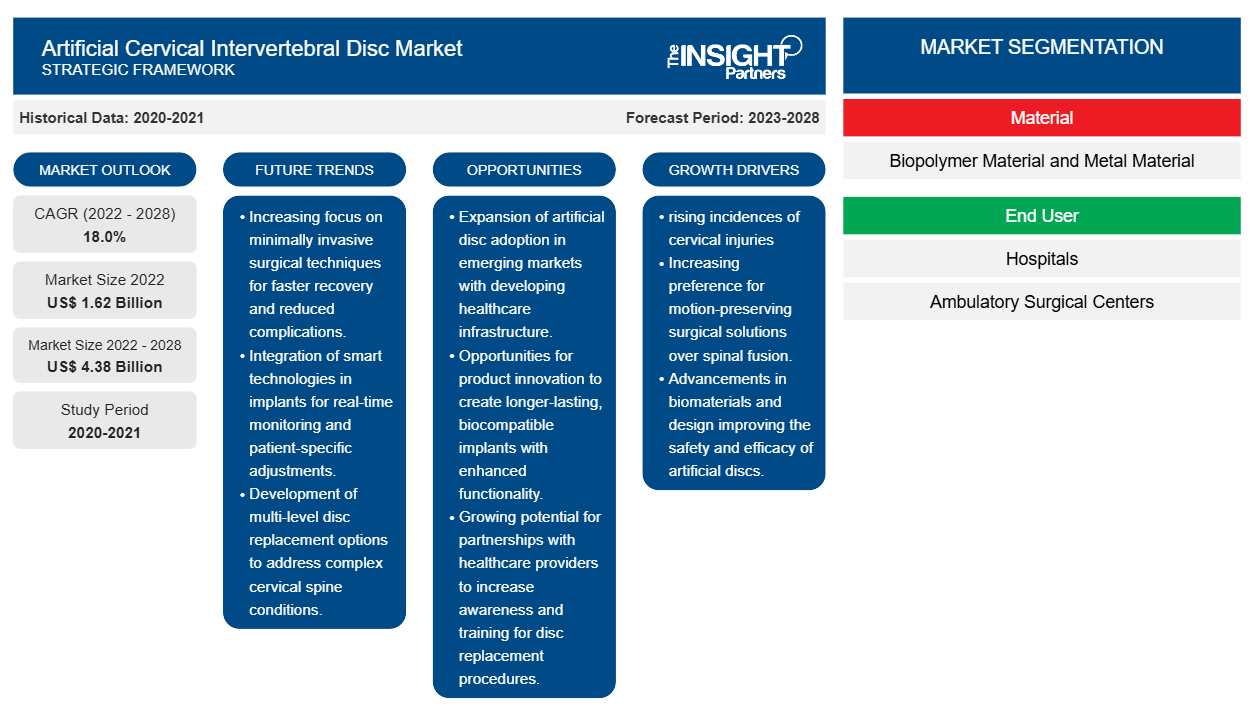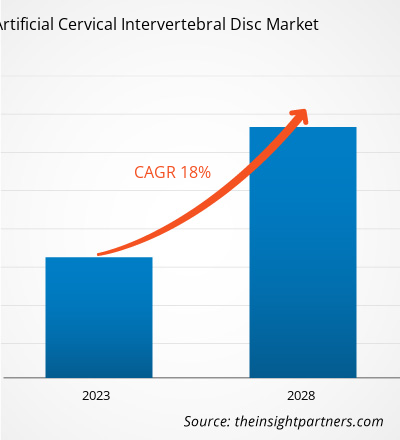[Rapport de recherche] La taille du marché des disques intervertébraux cervicaux artificiels devrait passer de 1 621,66 millions USD en 2022 à 4 375,29 millions USD d'ici 2028 ; elle devrait croître à un TCAC de 18,0 % de 2022 à 2028.
La croissance du marché des disques intervertébraux cervicaux artificiels est attribuée à la prévalence croissante des blessures cervicales. Les traumatismes sont le principal facteur de blessures cervicales, notamment les accidents de la route, les traumatismes pénétrants ou contondants, les chutes et les blessures liées au sport ou à la plongée. Selon l'étude « Estimating the Number of Traffic Crash-Related Cervical Spine Injuries in the US: an Analysis and Comparison of the National Crash and Hospital Data », publiée en 2020, aux États-Unis, environ 869 000 blessures de la colonne cervicale liées aux accidents de la route sont observées dans les hôpitaux chaque année, dont environ 841 000 sont des entorses/foulures (coup du lapin), 2 800 sont des lésions du disque vertébral, 23 500 sont des fractures, 2 800 sont des lésions de la moelle épinière et 1 500 luxations. En outre, la plupart des blessures sportives sont des blessures orthopédiques, notamment des foulures, des entorses, des fractures, des ligaments cassés, des douleurs et des gonflements ; celles-ci peuvent être aiguës ou chroniques. Selon Stanford Children's Health, environ 30 millions de jeunes et d'enfants aux États-Unis pratiquent un sport chaque année et plus de 3,5 millions de blessures liées au sport sont signalées chaque année. Une fracture cervicale résulte d'un traumatisme à haute énergie, comme une chute en gymnastique, au hockey, au football ou en plongée. L'incidence des fractures est élevée chez les athlètes. Selon le rapport Spinal Cord Injury Facts and Figures at a Glance, 2020, aux États-Unis, environ 7,8 % du total des lésions de la moelle épinière (LME) sont dues au sport. Selon la Commission américaine de sécurité des produits de consommation (CPSC), en 2018, environ 23 720 fractures du cou ont été traitées aux urgences des hôpitaux aux États-Unis ; parmi celles-ci, environ 3 194 étaient dues au sport. L'incidence des blessures sportives augmente avec la participation accrue aux sports et la participation active aux activités de remise en forme en raison de l'accent croissant mis sur une vie saine dans le monde entier. De plus, selon le National Spinal Cord Injury Statistical Center, la plongée est la cinquième cause de lésions graves de la moelle épinière cervicale. Par conséquent, la demande de disques intervertébraux cervicaux artificiels augmente en raison de l'incidence croissante des blessures cervicales.
Le disque intervertébral cervical a la capacité d'absorber une charge de compression énorme tout en offrant différents types de mouvement entre les os du cou. Les acteurs du marché ont développé plusieurs disques intervertébraux cervicaux artificiels qui sont utilisés pour traiter les problèmes de disques cervicaux. Le disque cervical artificiel remplace la fonction de mouvement et d'amortissement du disque cervical endommagé.
Personnalisez ce rapport en fonction de vos besoins
Vous bénéficierez d'une personnalisation gratuite de n'importe quel rapport, y compris de certaines parties de ce rapport, d'une analyse au niveau des pays, d'un pack de données Excel, ainsi que de superbes offres et réductions pour les start-ups et les universités.
- Obtenez les principales tendances clés du marché de ce rapport.Cet échantillon GRATUIT comprendra une analyse de données, allant des tendances du marché aux estimations et prévisions.
Informations sur le marché
L'augmentation de la population gériatrique stimule le marché des disques intervertébraux cervicaux artificielsIntervertebral Cervical Discs Market
Le processus de vieillissement affecte la colonne cervicale, le cou, les épaules, le haut du dos et les bras. La spondylose cervicale est un terme désignant l'usure liée à l'âge des disques vertébraux du cou. Il s'agit d'une maladie courante qui s'aggrave avec l'âge. Selon l'Académie américaine des chirurgiens orthopédiques, environ 85 % des personnes de plus de 60 ans sont touchées par la spondylose cervicale. Avec l'âge, les disques vertébraux, qui servent d'amortisseurs, s'assèchent progressivement et affectent la force. Selon la fiche d'information : Le vieillissement aux États-Unis, le nombre de personnes âgées de 65 ans et plus devrait atteindre environ 95 millions d'ici 2060, contre 52 millions en 2018, et sa part dans la population totale devrait passer de 16 % à 23 %. En outre, selon le rapport « Later Life in the UK 2019 - Age UK », environ 12 millions (11 989 322) de personnes âgées de 65 ans et plus au Royaume-Uni, dont 5,4 millions de personnes âgées de 75 ans ou plus et 1,6 million de personnes âgées de 85 ans. En outre, le Japon est un autre pays vieillissant, avec 28,7 % de sa population âgée de 65 ans ou plus. La société « super âgée » du pays est la plus âgée du monde. Ainsi, le vieillissement croissant de la population est susceptible d'accroître la demande de disques intervertébraux cervicaux artificiels.
Informations basées sur les matériaux
En fonction du matériau, le marché des disques intervertébraux cervicaux artificiels a été divisé en matériaux biopolymères et matériaux métalliques. Le segment des matériaux biopolymères devrait détenir une part plus importante du marché en 2022, la croissance étant principalement attribuée à la biocompatibilité et à la facilité d'insertion offertes par les disques en matériaux biopolymères. Cependant, le segment des matériaux métalliques devrait enregistrer un TCAC plus élevé sur le marché au cours de la période 2022-2028.
Les acteurs du marché des disques intervertébraux cervicaux artificiels adoptent des stratégies organiques telles que le lancement et l'expansion de produits pour étendre leur empreinte et leur portefeuille de produits à l'échelle mondiale et répondre à la demande croissante. Les développements des entreprises sur le marché mondial des disques intervertébraux cervicaux artificiels ont été caractérisés comme des développements organiques et inorganiques. Les stratégies de croissance organique adoptées par les acteurs du marché comprennent le lancement et l'expansion de produits. Les stratégies de croissance inorganiques observées sur le marché des disques intervertébraux cervicaux artificiels étaient des partenariats et des collaborations. Ces stratégies de croissance ont permis aux acteurs du marché d'étendre leurs activités et d'améliorer leur présence géographique. De plus, les stratégies de croissance telles que les acquisitions et les partenariats ont contribué à renforcer la clientèle de l'entreprise et à augmenter son portefeuille de produits. Les développements organiques représentent 80,95 % du total des développements stratégiques sur le marché, tandis que les stratégies inorganiques représentent 19,05 % de la croissance des entreprises.
Le marché des disques intervertébraux cervicaux artificiels a été segmenté comme suit :
Le marché des disques intervertébraux cervicaux artificiels est segmenté en fonction du matériau et de l'utilisateur final. En fonction du matériau, le marché est divisé en biopolymère et en métal. Le marché mondial des disques intervertébraux cervicaux artificiels, en fonction de l'utilisateur final, est segmenté en hôpitaux, centres de chirurgie ambulatoire et autres.
Aperçu régional du marché des disques intervertébraux cervicaux artificiels
Les tendances et facteurs régionaux influençant le marché des disques intervertébraux cervicaux artificiels tout au long de la période de prévision ont été expliqués en détail par les analystes d’Insight Partners. Cette section traite également des segments et de la géographie du marché des disques intervertébraux cervicaux artificiels en Amérique du Nord, en Europe, en Asie-Pacifique, au Moyen-Orient et en Afrique, ainsi qu’en Amérique du Sud et en Amérique centrale.

- Obtenez les données régionales spécifiques au marché des disques intervertébraux cervicaux artificiels
Portée du rapport sur le marché des disques intervertébraux cervicaux artificiels
| Attribut de rapport | Détails |
|---|---|
| Taille du marché en 2022 | 1,62 milliard de dollars américains |
| Taille du marché d'ici 2028 | 4,38 milliards de dollars américains |
| Taux de croissance annuel composé mondial (2022-2028) | 18,0% |
| Données historiques | 2020-2021 |
| Période de prévision | 2023-2028 |
| Segments couverts | Par matériau
|
| Régions et pays couverts | Amérique du Nord
|
| Leaders du marché et profils d'entreprises clés |
|
Densité des acteurs du marché des disques intervertébraux cervicaux artificiels : comprendre son impact sur la dynamique commerciale
Le marché des disques intervertébraux cervicaux artificiels connaît une croissance rapide, tirée par la demande croissante des utilisateurs finaux en raison de facteurs tels que l'évolution des préférences des consommateurs, les avancées technologiques et une plus grande sensibilisation aux avantages du produit. À mesure que la demande augmente, les entreprises élargissent leurs offres, innovent pour répondre aux besoins des consommateurs et capitalisent sur les tendances émergentes, ce qui alimente davantage la croissance du marché.
La densité des acteurs du marché fait référence à la répartition des entreprises ou des sociétés opérant sur un marché ou un secteur particulier. Elle indique le nombre de concurrents (acteurs du marché) présents sur un marché donné par rapport à sa taille ou à sa valeur marchande totale.
Les principales entreprises opérant sur le marché des disques intervertébraux cervicaux artificiels sont :
- Zimmer Biomet Holdings, Inc.
- Globus Médical, Inc.
- Centinel Spine, LLC
- Solutions Synergy Spine, Inc.
- Aditus Médical
Avis de non-responsabilité : les sociétés répertoriées ci-dessus ne sont pas classées dans un ordre particulier.

- Obtenez un aperçu des principaux acteurs clés du marché des disques intervertébraux cervicaux artificiels
Profils d'entreprise
- Zimmer Biomet Holdings, Inc.
- Globus Médical, Inc.
- Centinel Spine, LLC
- Solutions Synergy Spine, Inc.
- B. Braun Melsugen AG
- Aditus Médical
- AxioMed SARL
- NuVasive, Inc.
- Medtronic
- Analyse historique (2 ans), année de base, prévision (7 ans) avec TCAC
- Analyse PEST et SWO
- Taille du marché Valeur / Volume - Mondial, Régional, Pays
- Industrie et paysage concurrentiel
- Ensemble de données Excel


- Rugged Servers Market
- Airport Runway FOD Detection Systems Market
- Microcatheters Market
- Compounding Pharmacies Market
- Travel Vaccines Market
- GNSS Chip Market
- Health Economics and Outcome Research (HEOR) Services Market
- Resistance Bands Market
- Radiopharmaceuticals Market
- Vessel Monitoring System Market

Report Coverage
Revenue forecast, Company Analysis, Industry landscape, Growth factors, and Trends

Segment Covered
This text is related
to segments covered.

Regional Scope
North America, Europe, Asia Pacific, Middle East & Africa, South & Central America

Country Scope
This text is related
to country scope.
Questions fréquemment posées
An artificial cervical disc is a medical device designed to replace a natural disc in the neck through disc replacement surgery. It is inserted between two vertebrae in the neck and the surgery is generally performed in patients with a cervical disc herniation. The cervical artificial disc reduces the degradation of adjacent segments of the cervical spine and preserves normal neck motion.
The factors that are driving the growth of market are increasing incidences of cervical injuries and rising aging population. However, growing number of product approvals and developments is the major factor hindering the artificial cervical intervertebral disc market growth.
The artificial cervical intervertebral disc market majorly consists of the players, such as Zimmer Biomet Holdings, Inc.; Globus Medical, Inc.; Centinel Spine, LLC; Synergy Spine Solutions, Inc.; B. Braun Melsugen AG; Aditus Medical; AxioMed LLC; NuVasive, Inc.; Medtronic; and Orthofix Medical, Inc. among others.
The market is estimated to grow at a CAGR of 18.0% during the forecast period.
The artificial cervical intervertebral disc market is estimated to be valued at US$ 1,621.66 million in 2022.
The artificial cervical intervertebral disc market is expected to be valued at US$ 4,375.29 million in 2028.
The artificial cervical intervertebral disc market is analyzed on the basis of material and end user. Based on material, the market is segmented into biopolymer material and metal material. The biopolymer material segment held the largest share of the market. However, the metal material segment is anticipated to register the highest CAGR in the forecast period.
Asia Pacific is expected to be the fastest growing region in artificial cervical intervertebral disc market over the forecast period due to rising prevalence of the orthopedic diseases, increased in healthcare spending, and availability of advanced technology.
North America accounts for the major market share of artificial cervical intervertebral disc market in 2022 due to increasing aging population and the growing number of product approvals and developments.
Trends and growth analysis reports related to Life Sciences : READ MORE..
The List of Companies - Artificial Cervical Intervertebral Disc Market
- Zimmer Biomet Holdings, Inc.
- Globus Medical, Inc.
- Centinel Spine, LLC
- Synergy Spine Solutions, Inc.
- Aditus Medical
- AxioMed LLC
- NuVasive, Inc.
- Orthofix Medical, Inc.
- Medtronic
- B. Braun Melsugen AG.
The Insight Partners performs research in 4 major stages: Data Collection & Secondary Research, Primary Research, Data Analysis and Data Triangulation & Final Review.
- Data Collection and Secondary Research:
As a market research and consulting firm operating from a decade, we have published and advised several client across the globe. First step for any study will start with an assessment of currently available data and insights from existing reports. Further, historical and current market information is collected from Investor Presentations, Annual Reports, SEC Filings, etc., and other information related to company’s performance and market positioning are gathered from Paid Databases (Factiva, Hoovers, and Reuters) and various other publications available in public domain.
Several associations trade associates, technical forums, institutes, societies and organization are accessed to gain technical as well as market related insights through their publications such as research papers, blogs and press releases related to the studies are referred to get cues about the market. Further, white papers, journals, magazines, and other news articles published in last 3 years are scrutinized and analyzed to understand the current market trends.
- Primary Research:
The primarily interview analysis comprise of data obtained from industry participants interview and answers to survey questions gathered by in-house primary team.
For primary research, interviews are conducted with industry experts/CEOs/Marketing Managers/VPs/Subject Matter Experts from both demand and supply side to get a 360-degree view of the market. The primary team conducts several interviews based on the complexity of the markets to understand the various market trends and dynamics which makes research more credible and precise.
A typical research interview fulfils the following functions:
- Provides first-hand information on the market size, market trends, growth trends, competitive landscape, and outlook
- Validates and strengthens in-house secondary research findings
- Develops the analysis team’s expertise and market understanding
Primary research involves email interactions and telephone interviews for each market, category, segment, and sub-segment across geographies. The participants who typically take part in such a process include, but are not limited to:
- Industry participants: VPs, business development managers, market intelligence managers and national sales managers
- Outside experts: Valuation experts, research analysts and key opinion leaders specializing in the electronics and semiconductor industry.
Below is the breakup of our primary respondents by company, designation, and region:

Once we receive the confirmation from primary research sources or primary respondents, we finalize the base year market estimation and forecast the data as per the macroeconomic and microeconomic factors assessed during data collection.
- Data Analysis:
Once data is validated through both secondary as well as primary respondents, we finalize the market estimations by hypothesis formulation and factor analysis at regional and country level.
- Macro-Economic Factor Analysis:
We analyse macroeconomic indicators such the gross domestic product (GDP), increase in the demand for goods and services across industries, technological advancement, regional economic growth, governmental policies, the influence of COVID-19, PEST analysis, and other aspects. This analysis aids in setting benchmarks for various nations/regions and approximating market splits. Additionally, the general trend of the aforementioned components aid in determining the market's development possibilities.
- Country Level Data:
Various factors that are especially aligned to the country are taken into account to determine the market size for a certain area and country, including the presence of vendors, such as headquarters and offices, the country's GDP, demand patterns, and industry growth. To comprehend the market dynamics for the nation, a number of growth variables, inhibitors, application areas, and current market trends are researched. The aforementioned elements aid in determining the country's overall market's growth potential.
- Company Profile:
The “Table of Contents” is formulated by listing and analyzing more than 25 - 30 companies operating in the market ecosystem across geographies. However, we profile only 10 companies as a standard practice in our syndicate reports. These 10 companies comprise leading, emerging, and regional players. Nonetheless, our analysis is not restricted to the 10 listed companies, we also analyze other companies present in the market to develop a holistic view and understand the prevailing trends. The “Company Profiles” section in the report covers key facts, business description, products & services, financial information, SWOT analysis, and key developments. The financial information presented is extracted from the annual reports and official documents of the publicly listed companies. Upon collecting the information for the sections of respective companies, we verify them via various primary sources and then compile the data in respective company profiles. The company level information helps us in deriving the base number as well as in forecasting the market size.
- Developing Base Number:
Aggregation of sales statistics (2020-2022) and macro-economic factor, and other secondary and primary research insights are utilized to arrive at base number and related market shares for 2022. The data gaps are identified in this step and relevant market data is analyzed, collected from paid primary interviews or databases. On finalizing the base year market size, forecasts are developed on the basis of macro-economic, industry and market growth factors and company level analysis.
- Data Triangulation and Final Review:
The market findings and base year market size calculations are validated from supply as well as demand side. Demand side validations are based on macro-economic factor analysis and benchmarks for respective regions and countries. In case of supply side validations, revenues of major companies are estimated (in case not available) based on industry benchmark, approximate number of employees, product portfolio, and primary interviews revenues are gathered. Further revenue from target product/service segment is assessed to avoid overshooting of market statistics. In case of heavy deviations between supply and demand side values, all thes steps are repeated to achieve synchronization.
We follow an iterative model, wherein we share our research findings with Subject Matter Experts (SME’s) and Key Opinion Leaders (KOLs) until consensus view of the market is not formulated – this model negates any drastic deviation in the opinions of experts. Only validated and universally acceptable research findings are quoted in our reports.
We have important check points that we use to validate our research findings – which we call – data triangulation, where we validate the information, we generate from secondary sources with primary interviews and then we re-validate with our internal data bases and Subject matter experts. This comprehensive model enables us to deliver high quality, reliable data in shortest possible time.


 Obtenez un échantillon gratuit pour ce rapport
Obtenez un échantillon gratuit pour ce rapport